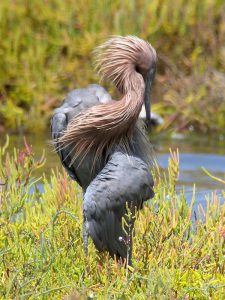When people find out I’m a birder, one of the most frequent questions is “What’s your favorite bird?” Sometimes I’ll give a flippant answer such as “My next life bird.” Other times, I’ll say that I love all birds and can’t pick a favorite – that each is special in its own way. I do have an affinity for Magnificent Frigatebirds, because seeing an adult male flying fifteen feet over my head while standing on a dock on Key West was the experience that triggered my choice to actively pursue the hobby of birding. But there are in fact some birds that are definitely cooler than others, be they prettier, uglier, sweet singers, or just plain quirky. One of these is the Reddish Egret (Egretta rufecens).
Reddish Egrets, once rare in Southern California, have been moving gradually up the coast. They now inhabit estuaries from San Diego through Ventura. Recently, they are visiting Santa Barbara. At Bolsa Chica Ecological Reserve, they are breeding. Birders frequently report sightings of 2 or 3 individuals.
Reddish Egret Hunting Behavior
As you will see in this video, Reddish Egrets have some strange behavior compared to other egrets and herons. Most egrets and herons stand still and wait patiently for their prey to appear, but Reddish Egrets are active hunters. They eat fish, frogs, and crustaceans. They hunt in brackish or salty water in coastal tidal flats, salt marshes, or lagoons.
First, they dance to stir up the bottom and get their prey to come out of hiding and swim around. Next, they chase after their quarry with long strides and neck extended a la Groucho Marx. They run to get between the prey and the sun. Then they pull back their head and spread their wings to shade the water to remove the reflections and glare that prevent them from seeing what is swimming around. Once they find their prey, they thrust their head forward to grab it. The Reddish Egret in this video seemed to have a pretty high success rate. I wonder if the effort it put into catching such tiny fish was worth the energy gained, but is sure is entertaining to watch.

This video was recorded using a micro 4/3 camera shooting through a Kowa TSN-884 spotting scope.

